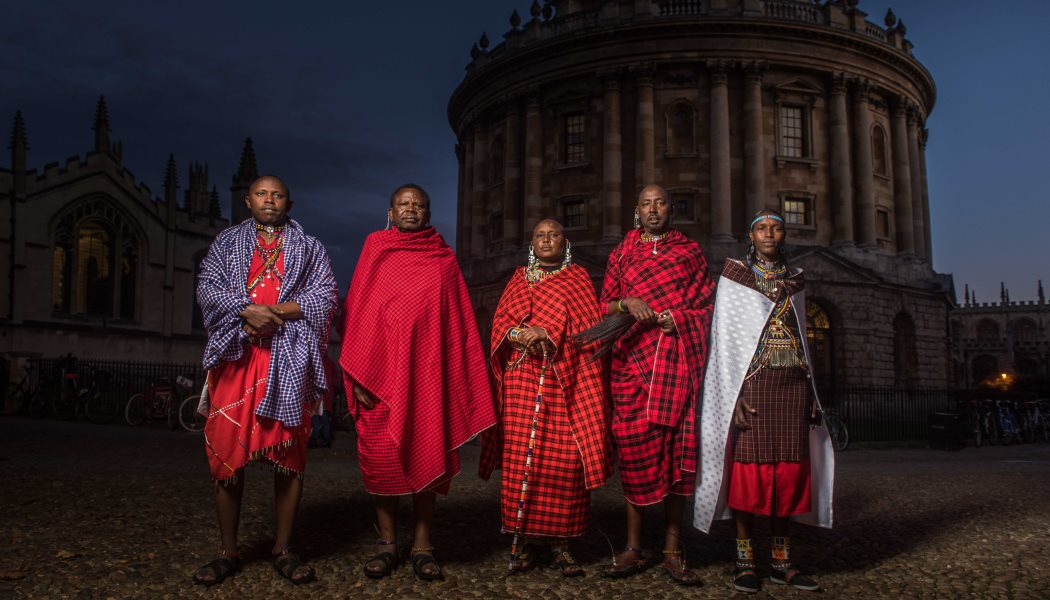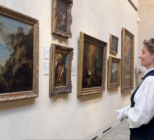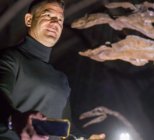We are a living culture, not a dead one, and we want to talk to the Museum about how they can change this
Living Cultures project is a unique collaboration between Oltoilo le Maa – a community based participatory video group formed in Loliondo, Tanzania in 2016 to document social events, human rights issues and local projects – Oxford University’s Pitt Rivers Museum and InsightShare, a community development organisation with 20 years of expertise in working with marginalised communities across the world using the unique power of participatory video for social change.
The five Maasai leaders from Tanzania and Kenya will be working with the Pitt Rivers Museums to share different narratives about their living cultures and relate them to the continuous struggles of the present. They will be collaborating with museum curators to realign stories and descriptions of artefacts, showcase their powerful films and discuss how they use participatory video to bring sharply into focus their current land rights campaign.
The Maasai leaders are working with the museum to ensure their concerns are taken seriously and change the way the Maasai living culture is represented beyond the framework of the imperial past. Tanzania suffered greatly under Omani slave trade from 1840, mostly concentrated in Zanzibar and also became part of the German colony of German East Africa from 1885, with Kenya falling under British rule as British East Africa around same time. But Maasai leaders will use this visit to the UK to raise awareness of the ongoing struggles Maasai communities face in Tanzania and Kenya to protect their land, resources and culture.
Those involved with this long-term project say its aims are ‘to change the narrative UK museums use to display Maasai artefacts and tell Maasai stories, and the hope is to grow this work over many years and inspire other museums to follow suit’.

The Living Cultures project began a year ago when Samwel Nangiria, Maasai leader and Director of Oltoilo le Maa, visited the Pitt Rivers Museum and witnessed how artefacts from his culture were displayed, while speaking at an event with Indigenous leaders at the museum.
Nangiria said at the time: “Seeing the way Maasai sacred objects were displayed in the Pitt Rivers Museum I felt shocked. We are a living culture, not a dead one, and we want to talk to the Museum about how they can change this. I believe that working together with the Pitt Rivers Museum and with our partners at InsightShare we can honour my community and present our real culture in the museum”.
Threatened territory
Nangiria is a Maasai activist and Director of NGO-Net in Loliondo and as a prominent member of the Maasai indigenous community he has for the past seven years been working to lead a campaign to secure the community’s threatened territory, land leased by the government in 1992 to a hunting company in Dubai, without the consent of the community.
He says the community has experienced forced evictions and has been fighting land-grabbing, and to raise awareness he has been using Participatory Video with the community to make their case, which resulted in him being acclaimed as Tanzania’s Rural Human Rights Defender of the Year 2016. “We’ve had journalists, we’ve had film crews, we’ve had photographers and we’ve seen how other people tell our story. Now it’s time for us to tell our own story,” he said.
When Nangiria returned home last year from his trip to the UK, he sent a significant message to Laura Van Broekhoven, Director of the Pitt Rivers Museum in which he powerfully outlined his concerns and hopes for the work that they could do together. He also spoke with the elders in his community and they created a film outlining their concerns.
Forming the Living Cultures project
Maasia leader, Samwel’s Nangiria email to the Pitt Rivers Museums stated:
“I am imagining a partnership, piloted between your museum and the Maasai around the inclusion of living culture in the bigger framework of the museum. This will accommodate thousands of indigenous peoples around the world and will provide a benchmark for a healing process for the so many damaged hearts, knowledge and cultures of these isolated/marginalised yet important groups on our planet”.
“Van Broekhoven said the email was inspiring inspiring and powerfully outlined the concerns and hopes he had for the work they could do together. “The Pitt Rivers Museum has a longstanding record of working with indigenous peoples in many different areas, but we have not worked with Maasai communities so we very much welcome the opportunity to work together and start this process,” she said. “The way Samwel phrased his aspiration spoke of radical hope and chimed very closely with the collaborative work we want to see happening at the Museum around inclusivity and with our Origins and Futures programme.”
The Origins and Futures programme, which the Living Cultures project is part of, welcomes, artists, elders and researchers to engage with collections and invites c0-curatorial engagement with displays.
Earlier this month the Pitt Rivers Museum and Oxford’s Museum of the History of Science launched a project called Multaka – Arabic for “meeting point” – that aims to help forced migrants foster connections between Britain’s cultural heritage and their own and trained Syrian refugees as tour guides.
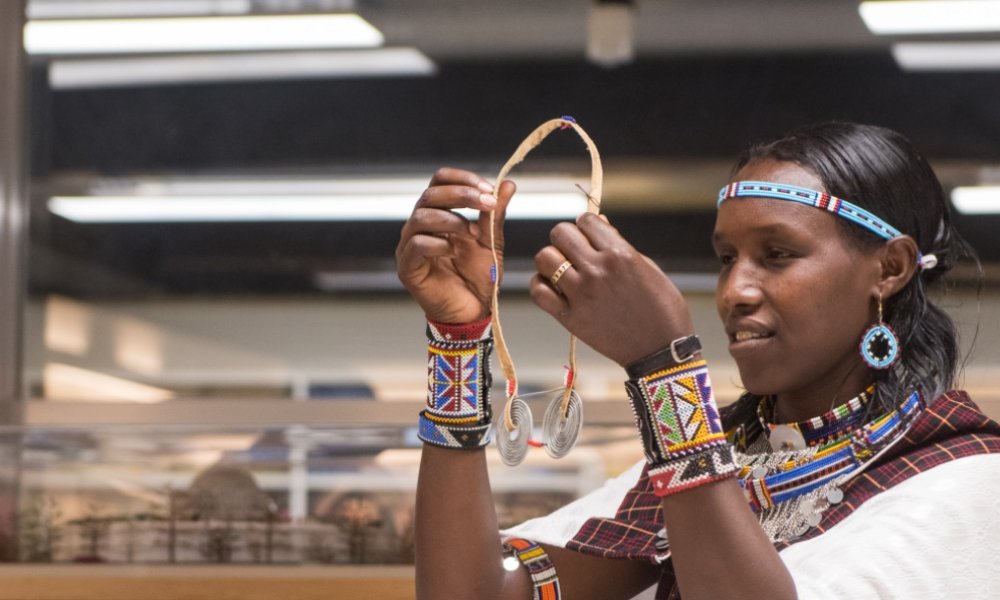
Pitt Rivers Museum is one of the finest archaeological and ethnographic teaching museums in the world. It was founded in 1884, when Lt General Pitt Rivers, an influential figure in the development of archaeology and evolutionary anthropology, donated his collection of more than 27,000 objects to the University of Oxford. Since them the museum has grown to steward 550,000 objects and carries out world-leading conservation and research and is currently focused on developing a more socially engaged practice.
Over the course of the two-week visit the Maasai will start the conversations with curatorial staff to see how indigenous living cultures can be better represented in the future. The results of these initial conversations, say the museum, will be brought into a public discussion at Pitt Rivers Museum to ‘explore how museums can play a role in enabling self-representation and redress and to discuss the role museums can play in the societal reparative process within this framework of radical hope and healing’.
The Maasai leaders will also introduce films they have made on land rights and traditional land management to the debate and we will report back on the first set of conversations.
This week groups will explore these debates and discussions on a retreat in Somerset with strategic allies and co-create a land rights campaign and at a public event at Building Centre in London to launch their land rights campaign.
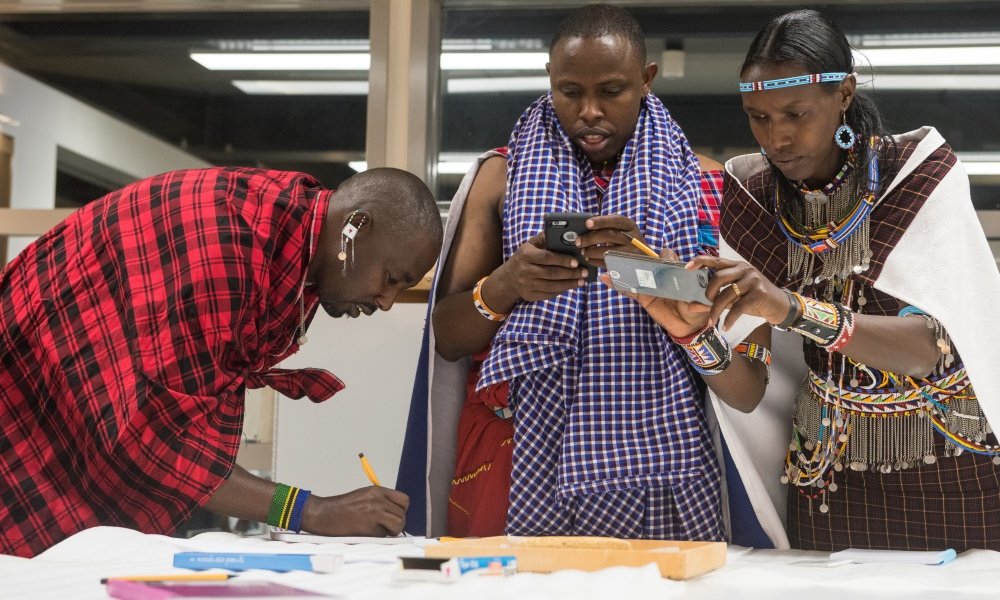
Nick Lunch, InsightShare Director, said: “Confronting our imperial past and bringing Maasai stories up to date, Living Cultures aims to raise awareness of the ongoing struggles indigenous peoples face to protect their land, culture and communities”. He says that Indigenous communities and their traditional ways of life are seriously under threat. “In Loliondo in Tanzania Maasai communities are facing illegal land-grabs, forced evictions and human rights violations: these are the harsh realities faced by Maasai communities today. Foreign ‘investment’ in Maasai territory has led to the burning of villages, intimidation and violence by the authorities. Erosion of language and culture is the inevitable consequence, perhaps the ultimate conclusion of colonialism.”
Participatory Video
InsightShare set up The InsightShare Network in 2016 as a not-for-profit entity to support Indigenous communities to harness the power of Participatory Video as a vehicle for change. In November 2017, they hosted a learning retreat and events showcasing the work of our founding indigenous members – Stories of Solidarity and Resilience. The Pitt Rivers Museum hosted the Oxford event, which was moderated by George Monbiot, and also provided a unique opportunity for our indigenous guests to interact with artefacts from the museum’s collection, from their cultures.
By use of a camera and participatory video, the Oltoilo le Maa group fights injustices and land grabbing, promotes best practice and the protection of Maasai culture. Using participatory video they produced Olosho, a powerful video exploring the ongoing land-rights struggle in Loliondo, Tanzania. The community’s land – sandwiched between the Serengeti, Maasai Mara and Ngorongoro – is under threat from foreign companies and they say the Tanzanian government is intent on evicting the Maasai and partitioning the land for luxury hunting of the world’s most valuable wildlife. The video enabled them to take the community’s concerns to politicians and decision makers, and successfully build on an earlier campaign, where 2.2 million people signed an Avaaz petition in 2013.
For an up-to-date picture of what’s happening to Maasai communities in Tanzania, the Oakland Institute (an independent think tank) has produced a detailed and damning report Losing the Serengeti: The Maasai Land that was to Run Forever. This article by The Ecologist reported the violent situation in 2015, and contains a video and photo by the Maasai video collective working with InsightShare.

